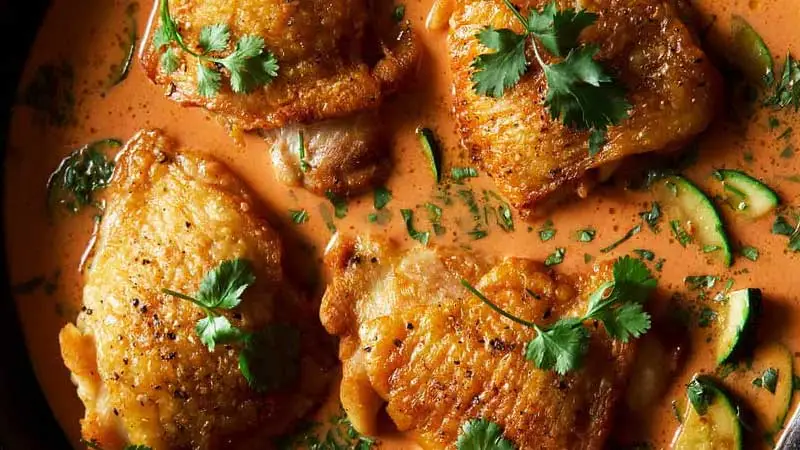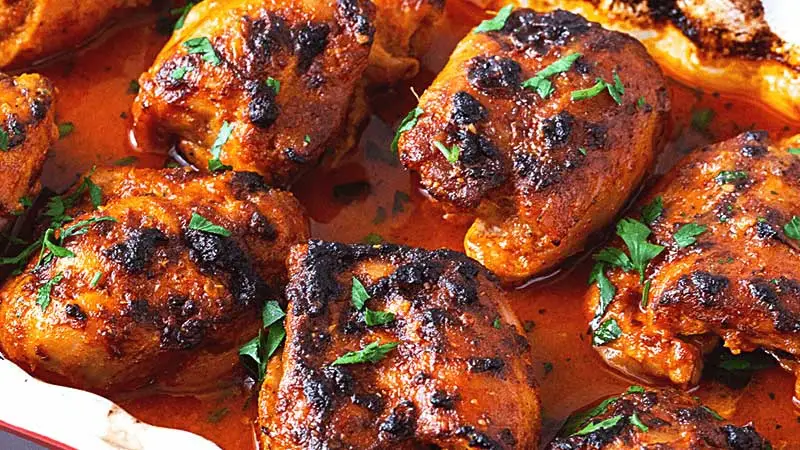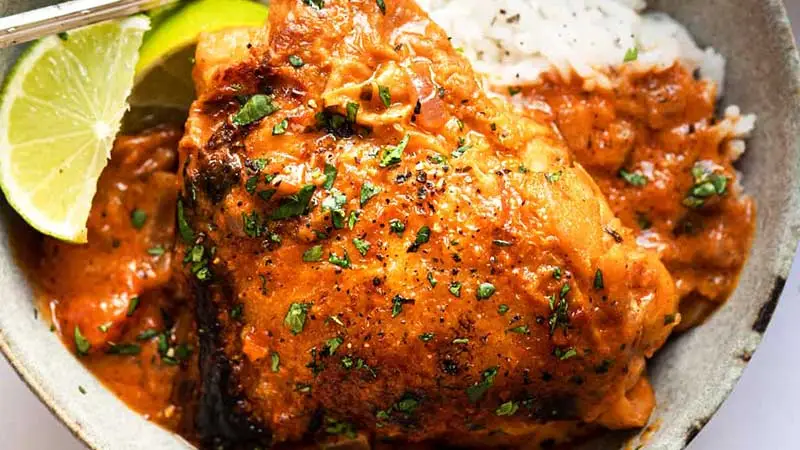Curry chicken thigh recipes are one of a kind. Curry chicken thigh recipes are something that attracts many people in the world. Curry chicken thigh recipes are not just a plate of food; they also provide relaxation and solace to one’s heart and mind.
However, many still don’t know what curry chicken thigh recipes are and how to create them. Many don’t know how to cook curry chicken thighs recipes at home.
What are the Curry chicken thigh recipes?
Well, curry chicken thigh recipes are one of the most popular recipes in the world. More and more people are looking for curry chicken thigh recipes from restaurants, cookbooks, and culinary experts. Of course, not all curry chicken thigh recipes are the same.
There are many different types of curry chicken thigh recipes that you can find around the world. Some curry chicken thighs dishes are mild with a hint of sweetness, while others have solid spices or spicy flavorings.

How Long Will It Take To Prepare?
- Prepare time: 15-20 minutes
- Cooking time: 30-35 minutes
- Total Time: 55 minutes
- Servings: 4 to 6
How to make the curry chicken thighs recipes?
Essential Ingredients For Curry chicken thigh recipes:
- Six bone-in chicken thighs
- 2 tbsp. vegetable oil
- One giant onion slashed
- Two garlic cloves minced
- 2 tbsp. curry powder
- 1 tsp. ground cumin
- 1/2 tsp. ground coriander
- 1/4 tsp. cayenne pepper
- One can (14 oz) diced tomatoes
- 1 cup chicken stock
- 1/2 cup coconut milk
- Salt and pepper to taste
- Slashed new cilantro for decorating (discretionary)
Directions For Curry chicken thigh recipes:
Step 1
Preheat your stove to 375°F.
Step 2
Heat the oil in a vast broiler-safe skillet over medium intensity. Add the chicken thighs and cook for 5-6 minutes on each side or until brilliant brown. Eliminate the chicken from the skillet and put it to the side on a plate.
Step 3
Add the onion to the skillet and cook until relaxed, around 3-4 minutes. Add the garlic and cook for one more moment.
Step 4
Add the curry powder, cumin, coriander, and cayenne pepper to the skillet. Cook for around one moment or until fragrant.
Step 5
Add the diced tomatoes and chicken stock to the skillet. Heat the blend to the boiling point, then decrease the intensity and let it stew for around 10 minutes.
Step 6
Mix in the coconut milk and season the combination with salt and pepper to taste.
Step 7
Return the chicken thighs to the skillet, skin side up. Spoon a portion of the curry sauce over the chicken.
Step 8
Move the skillet to the preheated broiler and prepare for 30-35 minutes or until the chicken is cooked.
Step 9
Once finished, remove the skillet from the broiler and let it cool for a few moments before serving. Decorate with cleaved new cilantro whenever wanted.

Additional Tips For Curry chicken thigh recipes:
- Chicken thighs are usually succulent and delightful, and keeping the skin on, and bones in will assist with holding dampness and add more flavor to the curry.
- Marinating the chicken in yogurt and flavors for around 30 minutes before cooking will assist with softening the meat and imbuing it with flavor.
- Toasting flavors like cumin, coriander, and fennel seeds before involving them in the curry will assist with delivering their regular oils and heighten their flavor.
- Coconut milk adds a decadent smoothness to the curry and supplements the flavors and chicken flavors.
- The overcooked chicken will become dry and extreme. Cook the chicken until it is recently finished, and afterward, eliminate it from the intensity.
- Adding vegetables like onions, carrots, chime peppers, and potatoes will add surface and flavor to the curry.
- Adding new cilantro or parsley and a crush of lime juice to the completed curry will light up the flavors and add a pop of newness.
- Curry is customarily presented with rice or naan bread, which assists with engrossing the delightful sauce and equilibrium out the flavors.

Precautions For Curry chicken thigh recipes:
- Cook the chicken entirely to an inside temperature of 165°F (74°C) to eliminate any destructive microbes that might be available.
- Keep hot food varieties hot (above 140°F or 60°C) and cold food sources cold (below 40°F or four °C) to forestall the development of destructive microorganisms.
- Assuming that utilizing canned coconut milk or other canned fixings, check the termination date and dispose of it whenever it lapsed.
- Utilize new fixings, particularly flavors, to guarantee excellent taste and avoid potential sanitation issues.
- If you have any food sensitivities, make a point to check the elements of the relative multitude of flavors and different fixings utilized in the recipe.
- Be cautious while handling hot dishes or skillets, and use stove gloves or pot holders to safeguard your hands.
Nutrition Facts Of Curry chicken thigh recipes:
| Nutrition | Amount |
|---|---|
| Calories | 391 kcal |
| Protein | 41 g |
| Carbohydrates | 18 g |
| Fat | 20.1 g |
| Cholesterol | 146 mg |
| Sodium | 3361 mg |
| Fiber | 3 g |
| Cholesterol | 150 mg |
7 Healthy Benefits Of Curry chicken thigh recipes-
1. Healthy Heart:
Curry chicken thigh recipes are rich in vitamins B6, C, and potassium. These are some essential nutrients to keep your heart healthy. These vitamins and minerals ensure good blood circulation. Heart disease can be prevented by consuming curry chicken thighs recipes regularly.
2. Healthy Teeth:
Curry chicken thigh recipes contain a high amount of manganese which is great for maintaining the strength of bones, connective tissues, cartilage, and bone marrow, which ultimately help in healthy teeth and gums.
3. Healthy Brain:
It improves memory and brain function and prevents Alzheimer’s and dementia by including curry chicken thighs recipes in your diet.
4. Healthy Eyes:
Curry is rich in vitamin A, which helps to maintain the health of the eyes and vision. This vitamin prevents night blindness, dry eyes, and cataracts to a great extent. Consuming curry chicken thighs recipes regularly may help better eyesight.
5. Boosts Energy:
Curry chicken thigh recipes contain many essential vitamins and minerals that are very good for boosting energy. These include vitamin B6, vitamin C, chromium, and copper. Copper is a vital mineral that helps achieve proper blood circulation. It also plays a crucial role in producing hemoglobin and red blood cells.
6. Good For Breast And Colon:
Curry chicken thigh recipes contain fiber for your colon and heart health.
7. Reduces Risk Of Cancer:
Curry chicken thigh recipes include plenty of vitamin A and zinc, which helps in preventing cancer. They are very effective in fighting against colon, breast, prostate, and lung cancers. You can increase your curry chicken thigh recipes by adding Turmeric to your regular diet.
Conclusion
Curry, chicken thigh recipes is a detailed article about preparing curry chicken meat. It has been written for those who are new to the preparation of curry chicken or want to try it out again. The article includes advice on the best cooking practices when cooking curry chicken thighs in clay pots and which spices and herbs would suit your taste.
People Frequently ask questions
Can I Use Any Other Sort Of Meat?
You can, but for best results, it is recommended to use chicken thighs since they are marinated in yogurt and spices, which helps them to be “tender.” Also, Indian Chicken Tikka (Cutlets) or Tandoori Chicken would work well too.
How Can I Make A Variation Of This Dish?
Please remove the chicken pieces and fry them separately in oil, with or without spices. Add the spices to a grease-free saucepan and heat, then add the chicken pieces. Simmer for some minutes, then add thick yogurt/curd and water.
Cover and cook on low flame till it is tender, then take out the chicken pieces onto a paper towel to drain off excess water and warm up in the gravy you have prepared from step 3 above.
What To Serve With This Chicken Curry In Restaurant Style?
This curry is usually served with basmati rice, but you can also do it with jeera rice or biryani rice. In addition, you can accompany the curry with onion naan, roti, or paratha (fried bread).
You can also serve this curry with fresh green chutney for that extra addition of taste. One last thing to do is to make a dipping sauce by pouring some fresh lime juice into the curry and stirring it in.
Do I Have To Marinate Them Before Cooking?
You can marinate it as long as you want. In the case of a restaurant-style, you don’t have to marinate it, and you don’t need to add yogurt, but you will have to add 2-3 tsp oil or any neutral flavorless oil. This will help to coat the chicken pieces and enhance their taste.
Can I Use Any Other Type Of Meat?
You can, but for best results, it is recommended to use chicken thighs since they are marinated in yogurt and spices, which helps them to be “tender.” Also, Indian Chicken Tikka (Cutlets) or Tandoori Chicken would work well too.
What To Serve With This Chicken Curry In Restaurant Style?
This curry is usually served with basmati rice, but you can also do it with jeera rice or biryani rice. In addition, you can accompany the curry with onion naan, roti, or paratha (fried bread).
You can also serve this curry with fresh green chutney for that extra addition of taste. One last thing to do is to make a dipping sauce by pouring some fresh lime juice into the curry and stirring it in.
How Do You Fry Them Without The Skin Getting Burned?
The secret is to watch it and ensure you rotate the pieces frequently. I usually fry one side on medium-high until it’s browned and then flip to the other.
Can I freeze it?
It can be frozen, but you must remove all the fried chicken and freeze them individually to retain its freshness.
Do you add more oil and yogurt if I use fewer chicken pieces?
If you have 2-3 chicken pieces, it will be sufficient to fry them and keep some of the mixtures in the pan to simmer it with a little bit of water or gravy.